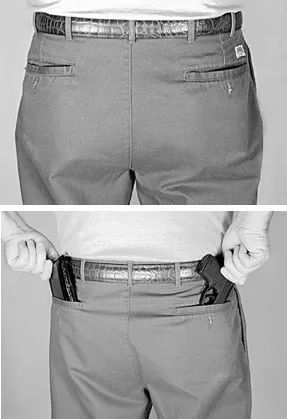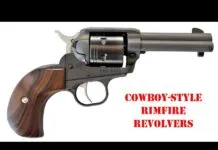
In this test we look at semi-automatic pistols that are small enough to fit into one’s pocket and avoid detection. One such pistol is the proven Kel-Tec P32. Because that gun fared well in a previous test of pocket pistols (October 2001), we wanted to see how the parent company’s slightly larger model in .380 ACP, the Kel-Tec P3AT, fared against the .32. To round out the field, we also tested another .32, this one a pistol from Guardian North American Arms in a proprietary cartridge, the .32NAA.
Naturally, we wanted to find out how reliable these guns were. We also wondered how much difference the round would make in this specific application, and we had questions about concealment and deployment. Is pocket carry safe? Under what conditions would these guns likely prove to be a valuable asset? Would these pistols convince us to buy into the concept of pocket pistols, or would we find too many liabilities for their owners to live with?
Here’s what we learned:
[PDFCAP(1)]
Kel-Tec CNC makes the .32 Auto P32 at its factory in Cocoa, Florida. The company currently makes three pistols, the two we tested here and a 9mm P11 model. All are locked-breech designs. The company also makes two rifles, the Sub 2000 carbine chambered for pistol cartridges and the SU-16 semiauto, chambered for the .223 Remington.
Kel-Tec pistols are popular for several reasons, including price, ease of function, and small size. The P32 weighs only 13 ounces, measures about 3 inches in height and 5 inches in length, and measures a slim 0.8 inch in thickness. Maximum capacity is seven rounds in the magazine plus one in the chamber. From the outside, it appears to be a polymer-framed pistol, but this is misleading. Like the other Kel-Tec pistols in 9mm and .380 ACP, the .32’s polymer grip actually houses an aluminum frame that connects with a steel slide. The finish on the 4140-steel slide of our P32 was Parkerized, but a lower-priced model with a blued finish costs only $300. Both finishes limit glare that can give away the presence of the gun, but a $355 hard-chromed version is also available, which may well make this gun more durable if not better looking.
On our test sample, the supplied sights consisted of a white line nestled in a relief of the slide just above the hammer channel in the rear and a white dot inset just below a triangulation atop the front of the slide. The barrels used on all the Kel-Tec pistols, according to the Kel-Tec website are SAE 4140 steel heat-treated to 48 HRC.
Operation of the P32 was via a locked breech system. The trigger face was made from polymer and hinged from the top. All shots were double action only. There was no external safety to render the trigger or hammer inoperable, but the firing pin was blocked automatically between shots from contacting the hammer. Due to the small size of this pistol, single-handed fire is probably the best idea. However, we did perform our accuracy study with a two-handed hold, but we had to be careful not to contact the slide and impede cycling. The only malfunction we suffered with this pistol came as the result of an observed obstruction of the slide by the shooter’s weak-hand thumb.
We shot these self-defense guns as they would likely be used, standing offhand at 7 yards. Our target was the Hoffner ABC16, which includes six numbered 3-inch circles and a humanoid schematic with an A-zone (chest), B-Zone (head), and C-Zone, the lower torso. Aim was accomplished more with the height and profile of the triangulation on the front of the slide than with matching the dot and lines of the front and rear sights. We noticed that our groups were often marred by a lone flyer, most often experienced during the first shot. We believe this has to do with how the slide returns to battery. We think chambering the gun by manually working the slide did not result in the same angle or quality of lockup as the result of firing. But even with the flyers, included our groups were measured at less than 2.5 inches. This is acceptable for a gun that will likely be called upon to fire at little more than arm’s length.
In terms of power we’re not sold on the .32 Auto from a short-barreled gun. Our choice of ammunition was limited to two different 71-grain FMJ rounds and one hollowpoint. Power between the Hornady and PMC FMJ rounds and the Speer Gold Dot Hollowpoints was about even, ranging from 89 to 93 foot-pounds of muzzle energy based on average velocities. This is just shy of some high-velocity .22 LR ammunition. Usually, the shooter has to choose between the penetration of the FMJ rounds or the expansion and delivery of energy of the hollowpoints. But we’re not sure that the velocity and mass of either of these rounds fired from the P32 was going to afford much penetration or much expansion, especially through heavy clothing. Still, we don’t think anyone reading this is willing to be shot with this combination.
[PDFCAP(2)]
Kel-Tec’s latest pistol is the P3AT. The P3AT appears to be the very same firearm as the P32, but with a noticeably larger hole in the muzzle. Capacity is 6+1, reduced by one round from the P32. The P3AT weighed in at 13 ounces, which is only one ounce more than the P32. We would hope that this indicates some stronger working parts to accommodate the more powerful .380, but the top end is about 0.1 inch longer on the .380 models. This might account for the extra ounce. Width on both models was the same, and again the only protrusion from their slim profiles was the magazine release. Operation and safety mechanisms were also identical.
The .380’s handling and trigger were also very much the same as the P32, and the increase in recoil was not a problem. We saw it as a welcome addition telling us that there was a little more going on out there on our behalf. The velocity of the .380 rounds was comparable to the .32 Automatic slugs, but due to the increased mass, muzzle energy was greater. The diameter of the .380 slugs is almost identical to those used in 9mm Parabellum loads. (Listed as 0.356 inch in diameter versus 0.355 inch). In fact, after its introduction in 1912 by John Browning, the .380 was referred to as 9mm Browning Short and later 9mm Kurz in Europe.
We found it easier to secure a wider variety of .380 ACP rounds than .32 Auto cartridges. We tested the P3AT with a 90-grain hollowpoint from Hornady, a 102-grain Golden Saber brass-jacketed hollowpoint from Remington, and a 95-grain FMJ round from Federal American Eagle. With velocities just short of 800 fps, muzzle energy ranged from 122 foot-pounds from the Hornady JHP/XTP rounds to 137 foot-pounds from the Golden Sabers. We experienced more consistent accuracy from the P3AT than from the P32. In fact we were able to land two five-shot groups that measured less than 2 inches, including a 1.3-inch group firing the Federal American Eagle rounds.
But we did find a couple of shortcoming in the Kel-Tec P3AT .380 ACP pistol. For one, the gun consistently grouped low at 7 yards. Is this a real problem? Probably not if it is viewed as a close-quarters weapon. Then again, we think it points out the need for more suitable sights. Perhaps the jump from the light payload of .32 Auto to the .380 would justify changing the rules for this design to include sights that adjust.
We also noticed that our P3AT would not lock back upon emptying the magazine. Although some shooters do prefer a non-locking setup, we are sure that this was not intentional. We noticed that the magazine in our P3AT sat much lower in the gun than did the magazine in the P32. We think each of these problems can be addressed, and that the increase in power with little or no increase in size makes the .380 ACP P3AT a better self-defense choice than the .32 Auto P32.
[PDFCAP(3)]
The Guardian series pistol from North American Arms of Provo, Utah, was expanded from its lineup of .32 Automatic and .380 ACP in 2002 to include a model chambered for a new round that would boast the highest velocity among pocket pistols. The new round was called the .32 NAA and was developed in partnership with Cor-Bon ammunition. The Guardian pistol itself, already fabricated from steel, was actually the .380 ACP model rechambered for this new cartridge. The .32 NAA is best described as a .380 ACP case necked down to hold bullets commonly used for .32 Automatic.
Our test Guardian was a double-action only, blowback-operated pistol fed from a magazine that holds six rounds. The 2.5-inch barrel was mounted solidly to the frame with the recoil spring and guide rod directly beneath it. The slide moved independently underneath the barrel, where it interlocked with the frame. The slide also rode along the side of the frame, but there were no rails. There was one slot inside the right side of the slide that fit with the slide release. This release did not hold back the slide when the gun was empty. The Guardian was not designed to lock back on an empty magazine. Instead, it functioned as a push button as the first step in removing the slide from the frame. Push in the release, pivot the slide upward, and remove it from the frame. To reassemble, simply reverse the process, but with the trigger pulled back far enough to move the hammer out of the way. We found that the slide snapped easily back into place.
The hammer fit flush, and even the magazine release was contoured by the polymer grip panels (with pebble finish) to make the body of the Guardian virtually snag free.
The Guardian came with a pamphlet filled with options and accessories such as a variety of sights, slide cuts, alternate finishes, fancy grip panels, porting options and holsters for inside the waistband, ankle, belt or pocket carry. We could have opted for the $200 Mitch Rosen Stingray skin holster, but our Guardian arrived with a miniature portfolio-style carry case complete with belt clip.
The pistol was nearly square, measuring 4.7 inches long and 3.7 inches tall. This included the pricey optional sights we ordered. For $199 extra, our Guardian arrived with three-dot night sights by Novak. The rear unit was ramped and snag resistant, but the front sight, being tall and highly visible, was a good candidate to impede a draw, we thought. The body of the front-sight blade was also longer than we would like, but this length likely facilitates and protects the tritium cells. We did ask ourselves about the value of night sights on a pocket pistol.
We liked being able to see the sights clearly, but at more than 40 percent over the gun’s base price, we’re not sure we got our money’s worth. Don’t misunderstand — the sights were great. We just couldn’t say that the mechanism beneath the sights allows the shooter to take advantage of the improved sight picture.
Like on the Kel-Tecs, the Guardian had no exterior mechanical safety to stop the trigger or hammer. If you do not want the gun to fire, then keep your finger off the trigger. Then again the 14-pound weight of the long double-action pull should reduce the incidence of unintentional fire. With a trigger this long and without any kind of visual or audible clues (like a cylinder rotating on a double-action revolver), you can press the trigger and never know how close you are to firing.
We had only one five-shot group measuring less than 3 inches in our range session. With the only two available rounds, (Cor-Bon 60-grain JHP and Cor-Bon 71-grain FMJ target loads) accuracy meant groups measuring 3 to 3.5 inches. The trick was not reading the sights; it was balancing the gun during a long hard trigger pull while holding it with only the ring and middle fingers across the front strap.
Also, recoil was not pleasant. No, we weren’t abused, but it was nothing to look forward to. We would say that the .32 NAA is a mean little caliber with bad intentions. The target loads moved at an average velocity of 1031 fps, and the hollowpoints averaged 1203 fps. (Advertised velocity was 1200 fps with muzzle energy of 192 foot-pounds.)
We mentioned above that porting was available for this little gun. As much as we like porting, we think small guns such as these lend themselves to shooter injury simply because the short barrel simply places the ports so close to the shooter’s face. Sure, the same would go for injury to an opponent. But firing while holding a ported Guardian close to the body would likely injure the shooter without doing anything but decreasing needed velocity and power.
We also noticed one more element that gave us pause. The 60-grain JHP rounds were, in our opinion, loaded too hot. We saw bulges around the firing-pin mark on the primer, indicating high pressures. If a case separated due to the pressure, the magazine might be forced downward out of the grip frame. Because the small grip forced us to place fingers directly below the magazine well, we wore shooting gloves to protect our hands in case high pressures forced the magazine out of the gun. As a result, we would not recommend shooting the 60-grain ammunition. We think the 71-grain target load had adequate power for defensive application.
Perhaps the answer is to load a hollowpoint rather than an FMJ bullet over the same powder charge. Still, we did notice that the FMJ bullets tended to tumble into the target, rotating end over end. This does increase effective bullet size and entry wound, but how penetration would be affected is hard to predict. Tumbling is generally caused by the case being crimped down too hard upon the bullet. We’re not surprised this problem exists because degree of crimp is one of the most basic problems encountered when loading bottleneck cases with jacketed pistol bullets that typically do not feature a crimp groove.
As a close-quarters weapon, the Guardian chambered for .32 NAA has a great deal of potential. However, a method of safe (and comfortable) carry needs to be carefully considered. Also, we wouldn’t want to overextend its role in our arsenal.
Gun Tests Recommends
Kel-Tec P3AT .380 ACP, $345. Our Pick. The P3AT has all the advantages of the P32 with enough added power to make us feel more comfortable. Both Kel-Tec pistols were fun to shoot, and with the proper retention system should be safe to carry and be put quickly into action.
Kel-Tec P32 .32 Auto, $340. Buy It. This little pistol was built to conceal in the pocket, and it does so without undue weight or drag. Its accuracy was better than the supplied sights. Even if power is not its strong suit, the P32 is far better than no gun at all.
North American Arms Guardian .32 NAA, $649. Conditional Buy. We’re not sure we would ask this pistol to be anything but a close-range weapon, thereby negating the extra cost for sights, (base price was $450). Its weight makes it suitable for on-the-belt carry only, forcing the .32 NAA to compete with larger calibers. Also, we observed dangerous pressure signs on some .32 NAA JHP ammunition.





























